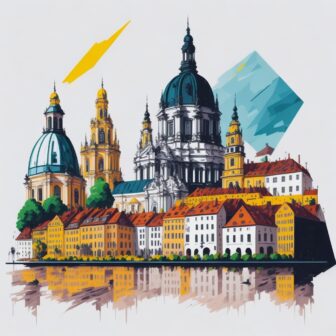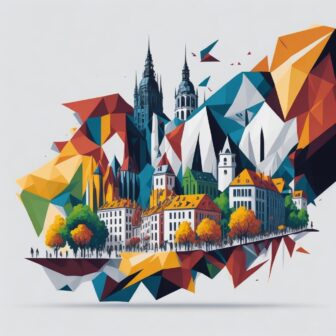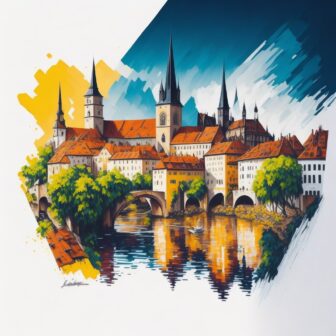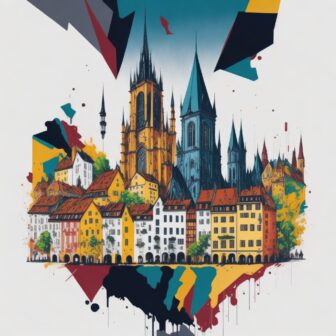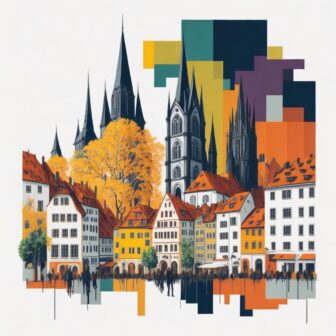15 Best Places to Visit in Weimar in 2023
Weimar is a captivating city in Germany that boasts an array of best places to visit, iconic landmarks, and fascinating attractions. Nestled in the heart of Thuringia, Weimar is a cultural gem known for its profound historical significance and contributions to art, literature, and philosophy.
As you stroll through its charming streets, you’ll be enchanted by the architectural wonders, lush green parks, and vibrant cultural scene that have made Weimar a UNESCO World Heritage site. Join us on this virtual journey as we uncover the captivating allure of Weimar and delve into its rich tapestry of history, creativity, and intellectual pursuits.
In a nutshell: Weimar Highlights
- Culturally, Weimar is one of the most important places in Germany, known as the city of classics due to the presence of renowned artists like Goethe, Schiller, and Bach.
- The old town of Weimar is a must-visit, with highlights including the houses of Schiller and Goethe, as well as the iconic Goethe-Schiller monument.
- The park on the Ilm, featuring Goethe’s garden house, is a significant sight and a must-see attraction in Weimar.
Follow in the footsteps of Goethe and Schiller or be fascinated by the art of Bauhaus: With over 25 museums and exhibition venues, Weimar presents a cultural heritage of national and international importance. However, the attractions of Weimar encompass more than just literature and art.
Weimar also offers impressive castles, impressive churches, beautiful parks and gardens.
I have listed popular attractions in Weimar for you and provide information on admission prices, opening hours, and history.
1. Goethe’s Residence
In Weimar, there are attractions that have a captivating effect on city travelers. Johann Wolfgang von Goethe’s former residence is definitely one of them.
The poet lived in several houses in Weimar throughout his life, but Goethe’s Residence refers to the distinctive building on the southeast side of Frauenplan.
In 1782, Goethe rented the western half of the house and lived there on and off for the next 10 years.
In 1792, it was purchased by the Ducal Chamber and assigned to Goethe as his official residence. In 1794, Duke Carl August gifted him the house, but it wasn’t officially transferred to Goethe until 1807.
After Goethe’s death in 1832, his family continued to live in the house. It was opened as a memorial site in 1886.
Accessible areas:
- Family living quarters
- Study
- Library
- Reception and art collection rooms
- House garden
- Goethe House Garden
The current state largely corresponds to the 1820s, with the former fruit and vegetable beds replaced by lawns.
Address: Frauenplan 1, 99423 Weimar
Opening hours: Closed on Mondays, Summer Tue-Sun: 9:30 am-6:00 pm, Winter Tue-Sun: 9:30 am-4:00 pm
Admission prices: Adults €13.00, reduced €9.00, with student ID (16-20 years) €4.00, children under 16 freeCombined ticket with Goethe National Museum: Next to the residence is the Goethe National Museum. Admission to the National Museum is already included in the ticket price for the residence.
2. Schiller’s Residence
Goethe and Schiller had a lively exchange during their lifetime. Their former residences are also just a two-minute walk apart.
Friedrich Schiller, also known as Schiller House, acquired the residence in 1802.
To raise the purchase amount, Schiller had to incur a high debt, even though he had already published today’s classics such as “The Robbers” (1781), “Intrigue and Love” (1784), or “Mary Stuart” (1800).
Only three years after the purchase, the debts were paid off.
He lived in the house during the last three years of his life and died in his study in 1805.
His family continued to live in the house until 1826 when it became the property of the city.
In 1945, the house was heavily damaged in bombings but could already be reopened in 1946.
Areas & Exhibits:
- Desk
- Bed
- Kitchen
- Servant’s room
- Exhibition on the history of the house
- Living quarters
- Reception and social rooms
Address: Schillerstraße 12, 99423 Weimar
Opening hours: Closed on Mondays, Summer Tue-Sun: 9:30 am-6:00 pm, Winter Tue-Sun: 9:30 am-4.00 pm
Admission prices: Adults €8.00, reduced €6.00, with student ID (16-20 years) €3.00, children under 16 freeCombined ticket with Schiller Museum: Next to Schiller’s Residence is the Schiller Museum. Admission to the museum is already included in the ticket price for the residence.
3. The Goethe-Schiller Monument
The Goethe-Schiller Monument is located on Theaterplatz in front of the German National Theatre in Weimar. The bronze double statue was unveiled on September 4, 1857.
Although Schiller was nearly 20 cm taller than Goethe, they were depicted as roughly the same height to symbolize their equality.
The necessary bronze for the statues was donated by King Ludwig of Bavaria and was made from the material of captured Turkish cannons. The double statue is even an export success: copies of the monument can be found in San Francisco, Milwaukee, and Cleveland, among other places.
4. Marktplatz Weimar (Market Square)
The Market Square of Weimar is located in the city center and is a popular starting point for a city tour.
The square is well-liked for its weekly market and the numerous historical buildings (such as the Town Hall, Stadthaus, and Cranach House) in and around it.
The Town Hall is a three-story building in the Neo-Gothic style with a representative balcony and bell tower. It was built in 1841 on the west side of the square.
Did you know? The current Town Hall is already the third of its kind in this location. The previous two Town Halls were destroyed by fire.
The Stadthaus is a green-and-white Renaissance building from the 15th century. It has been owned by the city since 1432 and was used as a council and trading house from 1526 to 1547.
Right next to the Stadthaus is the Cranach House, a listed Renaissance building from 1549.
In the 16th century, the painters Lucas Cranach the Elder and his son Lucas Cranach the Younger lived there.
5. The Zwiebelmarkt (Onion Market): Thuringia’s Largest Folk Festival
Every year, on the second weekend of October, the Zwiebelmarkt takes place on the Market Square with approximately 300,000 visitors.
The tradition of the market dates back to 1653. Over the centuries, it has become a regional attraction.
Since 1872, the Zwiebelmarkt even has its own market regulations.
Around 600 stalls offer everything related to onions, and a culinary highlight is the onion cake with new wine. Popular souvenirs are intricately braided onion garlands made of onions and dried flowers.
6. Weimar City Palace
In the city center of Weimar, at the northern end of the Ilm Park, lies the next popular attraction of Weimar: the City Palace, whose origins date back to the 10th century.
The former residence of the Dukes of Saxe-Weimar and Eisenach was transformed into a Renaissance palace from 1535 to 1604. Since then, numerous renovations and reconstructions have taken place at the palace.
After a fire in 1618, followed by the subsequent reconstruction and another fire in 1774, a palace construction commission was established in 1789 for the rebuilding of the palace. Interestingly, Goethe led the commission.
In 1835, the City Palace was converted into a museum by Grand Duchess Maria Pavlovna.
Today, the majority of the palace houses the City Palace Museum, which features a comprehensive exhibition focused on painting between 1500 and 1900.
Address: Burgplatz 4, 99423 Weimar
RELATED:
Famous Landmarks in Germany You Must Visit
7. Park on the Ilm
The Park on the Ilm, spanning an impressive 48 hectares, is not only the largest but also the most renowned park in Weimar. It is an absolute must-visit for nature enthusiasts and history buffs alike, offering a delightful combination of scenic beauty and fascinating attractions that showcase the rich heritage of Weimar.
Originally conceptualized by Duke Carl August and Johann Wolfgang Goethe, the park is a testament to their visionary garden artistry. As you explore its enchanting landscapes, you will discover a harmonious blend of elements, including intricate foliage compositions, picturesque pathways, and exquisite park architecture.
One of the park’s distinguishing features is its carefully designed sightlines, which connect several iconic landmarks. Along these visual axes, you will encounter notable sites such as Goethe’s Garden House, an intimate abode that served as Goethe’s first residence in Weimar.
It was within these walls that he penned some of his most renowned literary works, including the haunting ballad “Erlkönig.” Today, visitors can step into Goethe’s world by exploring the various rooms of the Garden House, including the cozy dining area, the well-equipped kitchen, and Goethe’s private spaces for work, relaxation, and sleep.
Another highlight along the sightlines is the Roman House, an elegant garden retreat that was originally built as the personal garden house of Duke Carl August. Within its walls, an interactive park model of the Park on the Ilm awaits, providing visitors with a captivating overview of the park’s layout and design. Additionally, the Liszt House, once the residence of the renowned composer Franz Liszt, opens its doors to allow access to its captivating music salon and study.
Stepping into this historical space, visitors can immerse themselves in the musical world of Liszt, gaining insight into the life and works of this influential figure.
In addition to its historical and cultural significance, the Park on the Ilm offers a peaceful and picturesque environment for leisurely walks, picnics, and moments of relaxation.
As you meander through its winding paths, you’ll be surrounded by lush greenery, fragrant blooms, and the gentle murmur of the Ilm River. The park’s serene ambiance creates an ideal setting for visitors to unwind, rejuvenate, and connect with nature.
When planning your visit to the Park on the Ilm, make sure to allocate ample time to fully explore its vast expanse and appreciate its many treasures. Whether you’re an admirer of horticultural beauty, a history enthusiast, or simply seeking a tranquil escape, this remarkable park offers a captivating experience that will leave a lasting impression.
Admission to Goethe’s Garden House is priced at €7.00 for adults, €5.00 for reduced admission, and €3.00 for students aged 16 to 20 with a valid student ID. Children under 16 can enter free of charge. The opening hours vary depending on the season, with winter hours from Tuesday to Sunday, 10:00 am to 4:00 pm, and summer hours from Tuesday to Sunday, 10:00 am to 6:00 pm.
8. The Herzogin Anna Amalia Library
The Herzogin Anna Amalia Library is another remarkable sight to behold in Weimar. Established in 1691 by Duke Wilhelm Ernst as the Ducal Library, it was later renamed in honor of Anna Amalia, the Duchess of Saxe-Weimar-Eisenach, on its 300th anniversary in 1991.
This library, dedicated to the study of literature and cultural history between 1750 and 1850, now houses an impressive collection of over 1 million media items. Open to the public, it serves as both an archive and a research library, offering valuable resources for scholars and enthusiasts alike.
One of the most notable figures associated with the library is none other than Johann Wolfgang von Goethe himself. From 1797 to 1832, Goethe served as the library’s director, leaving an indelible mark on its development and intellectual pursuits.
An intriguing aspect of the Duchess Anna Amalia Library is its virtual exhibition hosted by the German Digital Library. This digital platform allows visitors to explore the library’s vast author collection and delve into the literary treasures it holds.
The library’s architectural splendor includes the magnificent Rococo Hall, an integral part of the historic library building. This three-story hall stands as the central hub, housing the book restoration and conservation workshop, the Special Collections department, and the administrative offices. Its ornate design and grandeur truly transport visitors to another era.
Moreover, the library boasts the Renaissance Hall, which presents a captivating permanent exhibition titled “Cranach’s Flood of Images.” This exhibition provides a fascinating insight into the artistic legacy of Lucas Cranach and his influence on Renaissance art.
In addition to its extensive collections, the Herzogin Anna Amalia Library is also home to various specialized libraries and private collections. These include the Liszt Library, the Nietzsche Library, the Cranach Press, the Arnim Family Collection, the Faust Collection, the Shakespeare Library, and an array of autograph albums, collections from the Reformation era, almanacs, Bibles, maps, and globes.
To ensure a smooth visit, it is advisable to obtain tickets in advance due to limited access. Tickets can be purchased at the Weimar Tourist Information Center, directly at the library, or conveniently online through their website.
When exploring the library, be sure to immerse yourself in the wonders of the Rococo Hall, where virtual reality technology allows visitors to virtually leaf through the pages of books housed within. It’s a unique opportunity to engage with literary treasures and experience the charm of the library in a novel way.
Lastly, it’s worth mentioning the library’s remarkable journey of resilience following a devastating fire in September 2004. The library building and the adjacent Green Palace, including the Rococo Hall, were severely damaged.
Many invaluable works of art, 50,000 books, and a substantial portion of the collection were lost. However, through dedicated efforts, 28,000 books were successfully salvaged, including the Luther Bible from 1534.
Restoration work spanning over a decade revived the library’s glory, with 27 workshops across Europe contributing to the meticulous preservation of the book bindings.
The Herzogin Anna Amalia Library stands as a testament to the enduring power of knowledge and the indomitable spirit of those who strive to protect and share our cultural heritage.
Visiting the Herzogin Anna Amalia Library is a truly enriching experience.
Address: Platz der Demokratie 1, 99423 Weimar
Opening hours: from Tuesday to Sunday, 9:30 am to 2:30 pm. However, please note that the library is closed on Mondays.
9. Stadtkirche St. Peter and Paul Church
Let us now explore the remarkable Stadtkirche St. Peter and Paul. This renowned church stands as the most iconic religious structure in Weimar.
Stadtkirche St. Peter and Paul:
The present-day architectural masterpiece originated as a late Gothic-style hall church, constructed between 1498 and 1500.
Noteworthy individuals associated with this sacred place include:
- The foundations of the west tower boast an impressive historical legacy, representing some of the oldest surviving elements in the city.
- The exquisite winged altarpiece, a true artistic gem, was meticulously crafted by the renowned painter Lucas Cranach the Elder in 1554/55.
- Martin Luther, the influential figure in the Protestant Reformation, delivered numerous sermons within the sacred walls of this church.
- The melodies of Johann Sebastian Bach, one of history’s greatest composers, resonated through the halls of Stadtkirche St. Peter and Paul as he frequently graced the congregation with his musical talents.
- Johann Gottfried Herder, the esteemed poet, philosopher, and theologian, dedicated his services as the Generalsuperintendent of the Stadtkirche from 1776 until his passing in 1803. Consequently, the church has become affectionately known as the Herderkirche, paying homage to his significant contributions. Herder’s final resting place can be found in the adjoining cemetery.
Situated just north of the Stadtkirche is the Herderhaus, which served as Herder’s private residence. The house holds historical significance as it offers insights into the life of this eminent figure.
Adjacent to the house stretches a meticulously designed garden, adorned with a charming fountain, fruit-bearing trees, vibrant flowers, and more.
This tranquil haven held a special place in Herder’s heart. Thanks to detailed letters and an old city map, the garden was painstakingly reconstructed in 1994, preserving its original splendor.
Visitors have the opportunity to explore the captivating garden, immersing themselves in the serene ambiance. However, access to the interior of the house itself is not permitted.
Church Address: Herderplatz 8, 99423 Weimar
Garden Address: Herderplatz 8, 99423 Weimar
Opening Hours: Winter: Monday to Saturday: 10 am-12 pm & 2 pm-4 pm, Sunday and holidays: 11 am-12 pm & 2 pm-4 pm; Summer: Monday to Friday: 10 am-6 pm, Saturday: 10 am-12 pm & 2 pm-6 pm, Sunday and holidays: 11 am-12 pm & 2 pm-4 pm.
10. Jakobskirche (St. James’ Church)
The Jakobskirche, also known as St. James’ Church, is an illustrious landmark in Weimar and holds a significant place as part of one of the world’s most renowned pilgrimage routes, the Camino de Santiago to Santiago de Compostela.
The origins of this remarkable church can be traced back to its predecessor, which was constructed on the same site in 1168. However, due to structural deterioration, it was dismantled in 1712. Duke Wilhelm Ernst wasted no time and commissioned the construction of the present-day Jakobskirche, an elegant Baroque-style church with a single nave, just a year later.
Accompanying the church is the Jakobsfriedhof, the oldest surviving cemetery in Weimar. From 1530 until 1818, it served as the sole burial ground for the city’s inhabitants. Eventually, in 1818, a new cemetery, known as the “New Cemetery in front of the Women’s Gate,” was established to address the pressing space constraints.
Here’s an intriguing fact: The Jakobsfriedhof ceased to host burials from 1840 onwards. In 1927, the cemetery underwent a transformation and was converted into a beautifully landscaped garden, offering a peaceful oasis for contemplation and repose.
Notably, among the distinguished individuals interred in the Jakobsfriedhof are Lucas Cranach the Elder, renowned artist of the Renaissance, and Christiane von Goethe, the beloved wife of Johann Wolfgang von Goethe, the famous German writer and statesman.
It is worth noting that although Friedrich Schiller, another prominent figure of German literature, was initially laid to rest in the Jakobsfriedhof, his remains were later transferred to the prestigious Fürstengruft, or Ducal Vault, in 1827.
The Jakobskirche stands as a testament to Weimar’s rich heritage and its connection to the spiritual and cultural journeys of pilgrims throughout history.
Address: Am Jakobskirchhof 4, 99423 Weimar
Opening hours: April to October: Monday to Saturday 10 am-4 pm, Sunday from 11 am; November to March: daily from 11 am to 2 pm.
11. The Ducal Vault
Let’s continue our journey within the cemetery grounds as we explore the fascinating Fürstengruft, also known as the Ducal Vault. Constructed between 1823 and 1828, this magnificent structure serves as the final resting place for the noble Sachsen-Weimar-Eisenach family.
Located within the Fürstengruft are the resting places of two of the most celebrated figures in German literature: Goethe and Schiller. These iconic poets, whose works continue to inspire and captivate audiences, have found their eternal abode within the hallowed walls of this historic mausoleum.
It was in 1827 that Schiller’s remains were tenderly transferred from their original burial site at the Jakobsfriedhof to the serene embrace of the Fürstengruft. A few years later, in 1832, Goethe, the literary luminary whose influence shaped an era, was laid to rest beside his dear friend Schiller.
Interestingly, in 2008, meticulous research uncovered a startling revelation. The presumed remains of Schiller, believed to have rested within the Ducal Vault for nearly two centuries, were found to be those of other individuals. Consequently, the once occupied coffin of Schiller now rests empty, an intriguing testament to the complexities of historical preservation.
The Fürstengruft can be found within the captivating environs of the Historical Cemetery am Poseckschen Garten, a place steeped in history and reverence.
As you explore the Fürstengruft, you can’t help but be moved by the grandeur and solemnity that envelops this sacred space. The legacy of the noble Sachsen-Weimar-Eisenach family and the enduring literary contributions of Goethe and Schiller are beautifully preserved within the walls of this remarkable mausoleum, serving as a timeless reminder of their profound impact on the cultural heritage of Weimar and beyond.
For those eager to pay homage to the illustrious figures interred within the Ducal Vault, admission is available at reasonable prices.
Admission prices are as follows: Adults: €5.00, Reduced rate: €4.00, Students with valid ID (aged 16-20): €2.00, Children and adolescents under 16 years old: Free.
The opening hours are as follows: Closed on Tuesdays, open from 10 am to 6 pm during the summer season and from 10 am to 4 pm during the winter season.
12. Russian Orthodox Church
The Russian Orthodox Church holds a significant place within the historical context of Weimar. Adjacent to the Fürstengruft, there is an underground passage that leads to the Russian Orthodox Burial Chapel, a remarkable architectural gem.
This splendid chapel was constructed between 1860 and 1862, dedicated to the memory of the Russian Grand Duchess Maria Pavlovna. Being of royal lineage, it was her wish to be interred in her homeland’s soil. However, as the regent of Sachsen-Weimar-Eisenach, her final resting place had to be in Weimar.
To fulfill Maria Pavlovna’s desires, a unique solution was devised. Numerous loads of soil were meticulously transported from the vicinity of St. Petersburg to Weimar. With this precious soil, a sacred mound was raised, providing the foundation for the construction of the chapel.
Within this tranquil sanctuary, Maria Pavlovna found her eternal abode in the underground passage connecting the Fürstengruft and the burial chapel. This arrangement symbolically granted her the comfort of being laid to rest both in Russian soil and in close proximity to her beloved husband. Today, the chapel serves as a place of worship for the Russian Orthodox community in Weimar, hosting their religious ceremonies and gatherings.
Address: Karl-Haußknecht-Straße, 99425 Weimar
Opening hours: Closed on Tuesdays, open from 10 am to 6 pm during the summer, and from 10 am to 4 pm during the winter.
13. Belvedere Palace and Park
Venturing a bit south of Weimar, we encounter one of the city’s remarkable attractions: Belvedere Palace and its accompanying park.
Nestled within a sprawling 43-hectare landscape, the park boasts an array of captivating features, including the Orangery, a delightful pleasure garden, a mesmerizing maze, and the Gardener’s House, which hosts the captivating permanent exhibition titled “Guardians of the Golden Apples.”
Belvedere Palace, an exquisite example of Baroque architecture, was commissioned by Duke Ernst August I of Saxe-Weimar and Eisenach, and its construction spanned from 1724 to 1748. Drawing inspiration from the renowned Belvedere Palace in Vienna, it stands as a testament to the grandeur and artistic prowess of the era.
Did you know that within the palace walls, visitors can immerse themselves in the Porcelain Collection, marvel at a fascinating presentation on courtly hunting, and even embark on an interactive exploration of the park through a specially designed app called Weimar+? Whether it’s admiring delicate porcelain masterpieces or engaging in an augmented reality adventure, Belvedere Palace offers an enriching experience for all.
Over the years, the palace complex underwent expansions, incorporating charming pavilions, elegant clock houses, and splendid cavalier houses, all seamlessly integrated into the sprawling landscape park.
As the Duke’s consort, Duchess Anna Amalia harbored a longing for vastness, and thus, from 1758 onwards, she oversaw the transformation of the once-baroque garden into a picturesque landscaped park with a neoclassical-romantic ambiance.
Delve further into the park, and you’ll stumble upon a botanical marvel. By 1820, a magnificent Botanical Garden had taken root within the park’s boundaries, boasting an impressive collection of approximately 7,900 plant species from both domestic and international origins.
Walking through its meandering paths, visitors can embark on a botanical journey, marveling at the beauty and diversity of nature.
A notable highlight within the park is the enchanting Russian Garden, nestled to the west of the palace. This meticulously crafted garden was conceived as a heartfelt tribute by Grand Duke Carl Friedrich to his beloved wife, Maria Pavlovna. Painstaking efforts were made to recreate an almost exact replica of her cherished garden in St. Petersburg, capturing the essence of its allure within the Weimar landscape.
Following the abdication of the last Grand Duke, this grand Weimar attraction transitioned into the ownership of the Free State of Thuringia. Since 2003, it has been an integral part of the Klassik Stiftung Weimar, an institution born from the merger of the Weimar Classic Foundation and the Art Collections of Weimar, preserving and showcasing the region’s rich cultural heritage.
Address: Weimar-Belvedere, 99425 Weimar.
Opening Hours: During the summer season, the palace opens its doors from 10 am to 6 pm, closing only on Mondays. However, during the winter months, the palace remains closed.
Admission fees: adults can enter for €7.00, reduced tickets are priced at €5.00, students aged 16 to 20 can enjoy a discounted rate of €3.00, while children under 16 are granted free entry. Additionally, the park itself can be freely explored throughout the year, offering visitors ample opportunities to revel in its natural splendor and architectural treasures.
14. Bauhaus Museum Weimar
The Bauhaus Museum Weimar offers an enriching experience across its five levels, where a remarkable collection of 13,000 objects and documents is meticulously curated. This includes the renowned Ludwig Collection, which provides invaluable insights into the history of design, as well as the oldest existing Bauhaus collection in the world.
Visitors to the museum can marvel at an array of captivating exhibits, showcasing iconic works such as Marcel Breuer’s Lattice Chair, Marianne Brandt’s Teapot, and Theodor Bogler’s exquisite ceramics. These masterpieces exemplify the innovative spirit and artistic vision that defined the Bauhaus movement.
Initially established in 1995 as a temporary exhibition space housed within the former carriage house on Theaterplatz, the Bauhaus Museum Weimar has undergone a remarkable transformation.
In honor of the Bauhaus centennial in 2019, a new building was unveiled, embodying a harmonious blend of minimalistic design and refined architectural aesthetics. Its sleek lines, clear geometries, and expansive forecourt create a captivating visual experience, captivating visitors from the moment they arrive.
As dusk descends, the Bauhaus Museum Weimar becomes a captivating sight, as the building is gracefully illuminated by enchanting bands of light, casting a mesmerizing glow that accentuates its modernist allure.
Situated at Stéphane-Hessel-Platz 1, the museum beckons visitors to immerse themselves in its captivating displays and thought-provoking exhibitions. Opening its doors from Wednesday to Monday, the museum invites art enthusiasts and history aficionados to embark on a journey through the influential Bauhaus movement.
Upon visiting the museum, one can also explore the wider cultural landscape of Weimar. A combination ticket, known as the “Modern Ticket,” grants access to five remarkable modernist sites, including the Bauhaus Museum Weimar, Museum Neues Weimar, Haus Hohe Pappeln, Haus Am Horn, and the Nietzsche Archive.
This comprehensive pass offers a holistic experience, allowing visitors to delve into the rich tapestry of modern art, design, and cultural heritage that Weimar has to offer.
Step into the Bauhaus Museum Weimar and let the captivating exhibits and architectural marvels transport you into the innovative world of the Bauhaus movement, where art, design, and creativity converge in extraordinary ways.
Address: Bauhaus Museum, Stéphane-Hessel-Platz 1, 99423 Weimar
Opening hours: Wednesday to Monday (closed on Tuesdays) from 9:30 am to 6:00 pm
Admission fees: Adults €10.00, reduced €7.00, students aged 16-20 with student ID €4.00, children and adolescents under 16 free of charge
Combination Ticket “Modern”: €12.00 (includes admission to five modernist sites: Bauhaus Museum Weimar, Neues Museum Weimar, Haus Hohe Pappeln, Haus Am Horn, and Nietzsche Archive)
15. Buchenwald Memorial
The Buchenwald concentration camp stands as a somber reminder of one of Germany’s largest and most notorious concentration camps. Situated on the Ettersberg hill near Weimar, it held captive over 280,000 individuals between the years of July 1937 and April 1945.
Within the solemn grounds of the Buchenwald Memorial, the meticulous research conducted by its dedicated team has identified and documented 38,049 victims, shedding light on the immense human tragedy that unfolded within its walls.
Following the conclusion of World War II, the Soviet secret police utilized Buchenwald as an internment camp from 1945 to 1950. In the early 1950s, the camp underwent significant dismantling. However, in 1958, it was transformed into a National Memorial and Place of Remembrance, primarily focused on honoring the incarcerated and fallen communist resistance fighters who bravely opposed the oppressive regime.
With the fall of the Berlin Wall in 1989 and the subsequent reunification of Germany in 1990, a comprehensive redesign and reevaluation of the memorial took place. The aim was to encompass and acknowledge the experiences of additional victim groups, ensuring that their stories would not be forgotten.
Visitors to the Buchenwald Memorial have the opportunity to explore the outdoor areas, including the haunting remnants of the prisoner barracks, the administrative quarters once occupied by the SS, and the poignant burial grounds of Soviet Special Camp No. 2. These outdoor spaces are accessible daily until dusk, allowing visitors to reflect on the profound impact of this dark chapter in history.
Address: Buchenwald 2, 99427 Weimar-Nordstadt
Admission: Free
Opening Hours: Closed on Mondays. From April to October, open Tuesday to Sunday and on public holidays from 09:00 to 18:20. From November to March, open Tuesday to Sunday and on public holidays from 09:00 to 16:20.
Weimar stands as a captivating destination filled with an abundance of historical and cultural treasures. From the grandeur of the Goethe House to the serene gardens of Schloss und Park Belvedere, there is no shortage of sights and landmarks to explore. Delve into the world of design at the Bauhaus-Museum Weimar, or pay homage to the victims of the past at the poignant Gedenkstätte Buchenwald.
Don’t miss the awe-inspiring Jakobskirche and the Fürstengruft, which offer glimpses into the city’s rich history. With its diverse array of attractions, Weimar truly captures the essence of a memorable travel experience. Whether you’re drawn to art, history, or natural beauty, this enchanting city has something for everyone. Plan your visit today and discover the best of Weimar’s captivating allure.

